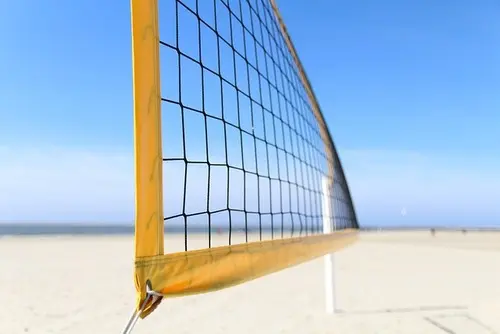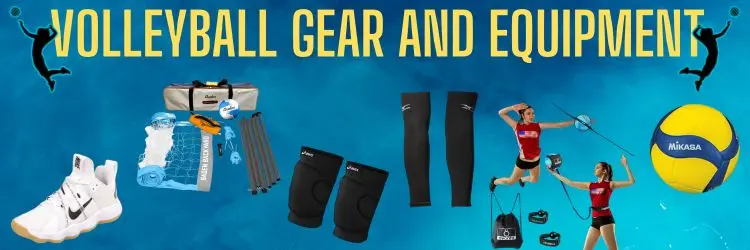Net Rules in Volleyball

Net Rules in Volleyball: Specifications and Guidelines
One of the central components of volleyball is the net. Understanding the rules and specifications of the volleyball net is essential for players, referees and enthusiasts alike.
In this article we’ll talk about the dimensions, construction and rules surrounding the volleyball net to provide a comprehensive guide for anyone involved in the sport.
Specifications of the Volleyball Net
Dimensions and Construction
Height of the Net:
- For men’s volleyball, the net height is set at 2.43 meters (7 feet 11 5/8 inches).
- For women’s volleyball, the net height is 2.24 meters (7 feet 4 1/8 inches).
- For mixed gender recreational play, the height is often adjusted based on agreement or specific league rules.
Width and Length:
- The net is 9.5 to 10 meters (31 feet 2 inches to 32 feet 10 inches) wide.
- The height from the top of the net to the bottom is 1 meter (39 inches).
Material:
- The net is constructed from durable mesh material, typically made of synthetic fibers like nylon.
- The mesh squares should measure 10 cm (4 inches) on each side.
Top and Bottom Cords:
- A white band runs along the top of the net, typically 5 cm wide, housing a steel cable or cord for tension.
- A similar band and cord are present at the bottom, ensuring the net maintains its shape during play.
Side Bands and Antennas:
- Two white vertical bands, 5 cm wide, are placed on either side of the net. These are aligned with the sidelines of the court.
- Antennas, 1.8 meters long and made of flexible material, extend 80 cm above the net. They are used to define the vertical boundary of the crossing space.
Rules Regarding the Net
Contact with the Net
Player Contact:
- Players are not allowed to touch the net during play. Any contact, whether intentional or accidental, is considered a fault if it interferes with the play.
- Exceptions: Incidental contact with the net that does not affect the play is not penalized.
Ball Contact:
- The ball can touch the net during a rally. This is not considered a fault unless it results in the ball falling out of play or makes the ball unplayable.
Crossing the Net
Reaching Over the Net:
- Players may reach over the net to block an opponent’s attack hit as long as the action does not interfere with the opponent’s ability to play the ball.
- A player is not allowed to attack the ball over the net until the ball has crossed the plane of the net into their side of the court.
Crossing Under the Net:
- Players may cross under the net as long as they do not interfere with the opponent’s play or create a safety hazard.
- If a player’s entire body crosses the centerline under the net, it is typically considered a fault.
Net Serves
Service Rules:
- A serve that touches the net but lands in the opponent’s court is considered valid and playable.
- If the ball fails to cross the net completely during a serve, it is a fault.
Block and Attack Rules
Blocking:
- Blockers can contact the ball above the net, provided they do not interfere with the opponent’s play.
- After a block, players are allowed to make a second contact to continue the rally.
Attacking:
- Players in the back row cannot attack the ball above the height of the net when positioned in front of the attack line (3 meter line).
Regulations for Net Setup and Maintenance
Proper Installation:
- The net should be securely fastened to the posts on both sides to ensure consistent tension.
- Posts should be placed 0.5 to 1 meter outside the sidelines of the court.
Height Adjustments:
- The net height must be checked before the start of each match to ensure it meets the required standards.
Condition of the Net:
- The net should be free of tears, loose threads, or damage that could interfere with play or pose a hazard.
Visibility:
- The net should be clearly visible against the background to ensure players and referees can see the ball’s interaction with the net.
Faults Involving the Net
Net Touch by a Player:
- Any part of the player’s body or uniform touching the net during play is a fault.
Ball Failing to Cross the Net:
- If the ball does not cross the net during an attack, serve, or rally, the opposing team earns a point.
Illegal Crossing:
- A player crossing completely under the net and interfering with play results in a point for the opposing team.
Interference with Antennas:
- The ball or player touching the antennas is considered out of bounds and results in a point for the opposing team.
Special Cases and Adaptations
Beach Volleyball:
- In beach volleyball, the net height remains the same, but the rules surrounding net contact are more lenient. For instance, players can brush the net without penalty as long as it does not interfere with the rally.
Youth and Recreational Volleyball:
- Net height for younger players or recreational play may be adjusted based on age group or skill level.
Examples:
- U12 boys and girls: 2.13 meters (7 feet).
- U14 boys and girls: 2.24 meters (7 feet 4 1/8 inches).
Conclusion
The net is a central element of volleyball that adds to the challenge and excitement of the game. Its specifications and the rules governing its use ensure fair play and maintain the integrity of the sport.
Whether you’re a player, coach, or referee, understanding these net rules is essential for proper gameplay and enjoyment of volleyball. By adhering to these guidelines, participants can focus on skill development, strategy and the thrill of the game.


